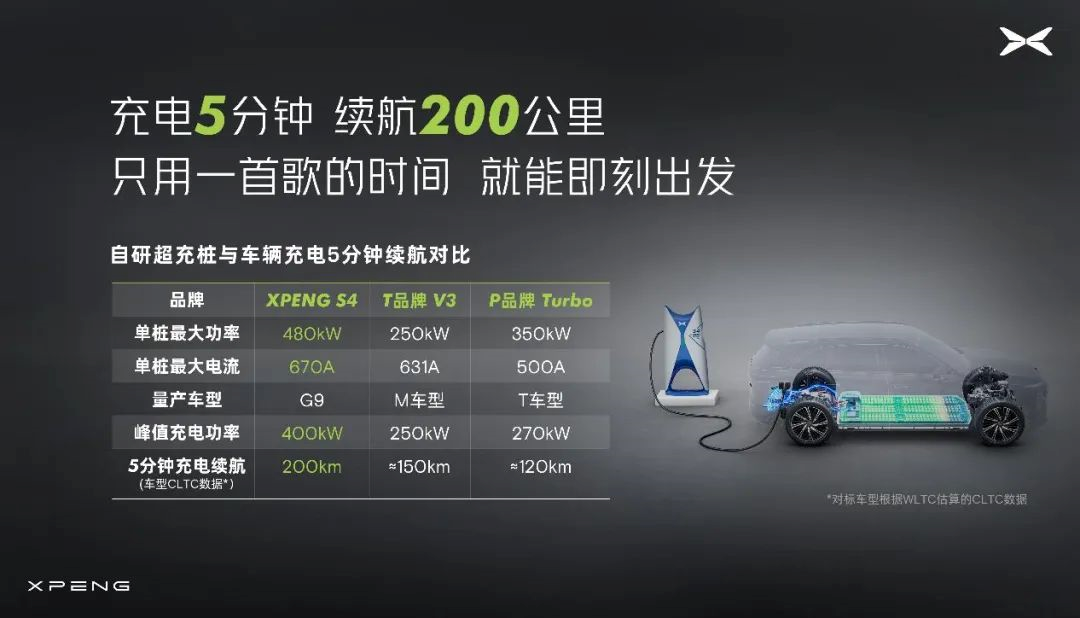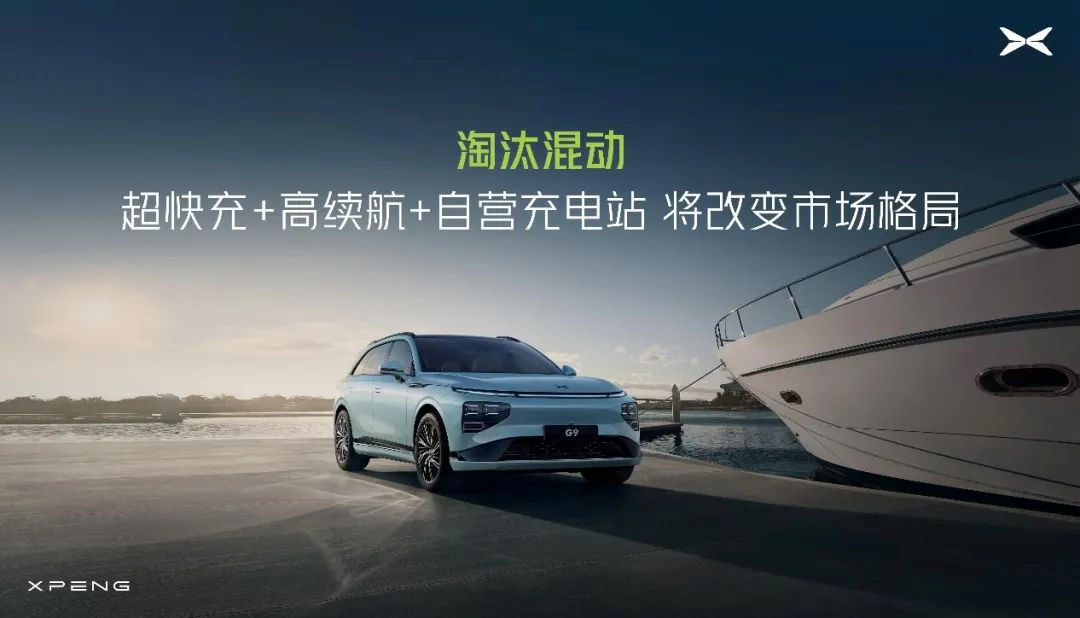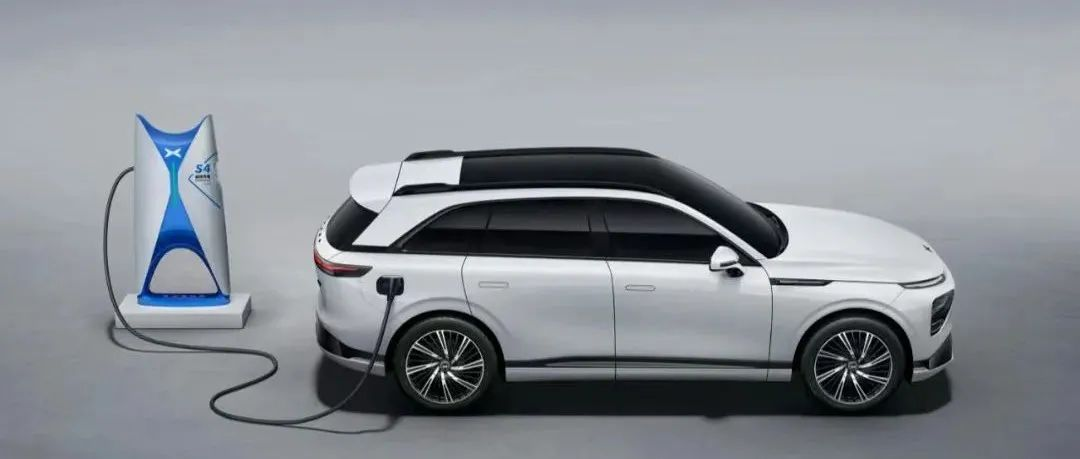Writing | Leng Zelin
Editing | Wang Pan
The anxiety of energy supplement and mileage has always been the core issue for most potential buyers of electric vehicles. Different automakers have provided different solutions such as extended range, plug-in hybrid, fast charging, and battery swapping under the current technological capabilities and environment.
Among these solutions, optimizing the powertrain is generally considered a transitional approach, while improving the efficiency of fast charging and battery swapping and extending the range is the best comprehensive solution towards pure electric models.
This week, XPeng Motors has entered the battle of the new energy supplement system with its S4 super fast charging station.
Different from the two mainstream models of high-voltage fast charging and high-current fast charging on the market, the XPeng S4 not only has a high voltage of 800V but also a maximum current of 670A. The combination of the two provides a maximum power of 480kW for a single station, with a range of about 200km in just 5 minutes. The charging efficiency of XPeng S4 super fast charging station surpasses Tesla V3 and Porsche Turbo. In the on-site video test, the XPeng S4 super fast charging station achieved the result of increasing the range by 210km in 5 minutes.

In the view of He XPeng, CEO of XPeng Motors, the system of super fast charging, high range, and self-operated charging stations will change the industry landscape.
The Duel between Super Fast Charging and Hybrid
Since 2021, the penetration rate of new energy vehicles in China has continued to set new records. The latest data shows that the penetration rate has reached 22.7% in the first half of 2022.
Such a speed has also led to multiple changes in He XPeng’s estimation of the penetration rate of new energy vehicles in China for 2025, including 30%, 35%, 50%, and so on. This speed has already exceeded the imagination of many people.
The rapid increase in the number of new energy vehicles also easily conflicts with the insufficient energy supplement system. According to the travel during multiple holidays last year, conflicts have already surfaced in some regions. If the system is not improved, the penetration rate of new energy vehicles will eventually reach a bottleneck.
In He XPeng’s view, the demand for energy supplement in the entire market changes with the change of vehicle prices.

For vehicles priced below RMB 100,000, due to the limited battery capacity and range, they are mainly used for city commuting and suburban travel, and home charging or regular fast charging already provides relatively complete energy supplement service. Therefore, pure electric models are rapidly replacing fuel vehicles. For vehicles priced between RMB 100,000 and RMB 200,000, hybrids have shown outstanding performance. The emergence of series-parallel hybrid models gives them both economic and convenient advantages, like BYD’s sudden rise last year.## How can pure electric SUVs above 200,000 or even 300,000 stand out in terms of advantages given the changes in size and increased consumer demands?
XPeng’s answer is long range and ultra-fast charging, which also fits the requirements of XPeng’s car system. Therefore, XPeng takes the lead in the industry and becomes the pioneer of ultra-fast charging.
In XPeng’s opinion, ultra-fast charging is basically the entry-level of the next generation of mid-to-high-end models.
However, due to the need for coordination between cars, poles, and batteries, hybrid vehicles still have strong vitality.
XPeng’s supplement plan
To pass through the intermediate period quickly and smoothly, let’s take a look at XPeng’s supercharging plan.
At present, XPeng has four generations of charging poles, namely S1-S4. S1 has a small number of early products; S2 is the most numerous XPeng supercharging pole on the market, with two specifications of dual-gun 180kW or dual-gun 120kW. S3 is not officially released yet, but its power is 360kW, and all versions of XPeng G9 except the top-of-the-line version support S3.
As mentioned earlier, the rapid increase in penetration rate has also made car companies need to adjust the rhythm of charging system construction in a timely manner. Considering that the latest models already support S4 supercharging, the deployment scale of S4 will be greater than that of S3.
XPeng also admits that XPeng’s supercharging system was somewhat controlled in the second and third quarters of this year. In other words, there are few car models that currently support ultra-fast charging on the market, and only the top configuration of XPeng G9 supports it.
Ultra-fast charging is a complete system, and the construction of poles cannot be too fast, otherwise the construction and operation costs of the enterprise will be too high; car models cannot be launched too fast, otherwise it will be difficult to ensure the balance between cars and poles.
In fact, hybrid power is also the same logic, that is, to achieve a balance between range, economy, cost, and convenience, etc. From the current stage, ultra-fast charging and hybrid power are in the same stage of supplementing energy.
However, it can be foreseen that the experience improvement of hybrid power will be lower than that of ultra-fast charging. The former is nothing more than improving fuel efficiency and optimizing power switching logic, while the latter can further improve the energy supplement and driving experience of new energy vehicles by improving network density, charging speed, and even optimizing charging planning.
According to the data provided by XPeng officials, without home charging, pure electric models can commute for more than one week after one charge, while hybrid models need to charge 2 to 3 times a week, which will increase costs if refueled, and the NVH and driving experience of hybrids are slightly insufficient under feed-back conditions.
How will XPeng surpass hybrid power? XPeng mentioned two points, one is the map, and the other is the density.
This year, XPeng will launch the next-generation charging map, which can plan travel routes for users by algorithmically combining XPeng S1-S4 and home charging poles, and providing appointment distance, cost reference, etc.## Charging Network and Fast Charging Infrastructure
In terms of the charging network, Xpeng already has 1000 charging stations and plans to build an additional 2000 supercharging stations by 2025, some of which will be upgraded from existing charging stations to S4 supercharging stations.
On high-demand highways, Xpeng will deploy a large number of S4 charging stations and energy storage stations at major locations and exits.
XPeng He believes that when plug-in hybrid car owners see complete charging equipment during their journeys, their next car will often be a pure electric car.
Battery Swapping and Supercharging: Two Rapid Recharging Methods
In fact, when it comes to supercharging, we cannot avoid mentioning battery swapping, because both are part of a rapid recharging system. They are becoming more and more similar in form, such as Xpeng’s exploration of combining energy storage and charging and the form of the next generation of energy storage supercharging stations.
This summer, the temperature in the Sichuan-Chongqing region did not drop, and in southwest China’s major city Chengdu, the local weather bureau confirmed the high temperature warning for the 7th time on August 18, based on the red warning issued on August 11th at 1:00 p.m. The prolonged high temperature has caused drought and lowered the water level of major rivers, which has posed unprecedented challenges to the electricity supply of the whole Sichuan-Chongqing region, and resulted in the forced blackout of Tesla, NIO, and other automakers’ charging infrastructure.
Shen Fei, Vice President of NIO, recently stated on social media that electric vehicles will help regulate the pressure on the power grid.
In fact, NIO’s battery swapping station and Xpeng’s energy storage station can also be seen as larger energy storage devices, making full use of off-peak electricity and providing supplementary power for peak demand. Currently, Xpeng’s energy storage station also has the ability to reverse charge back to the grid.
At present, Xpeng’s S4 supercharger does not have energy storage, and the total power of a 4-stack supercharging station is 480kW. When there are more cars, the efficiency of charging one car will decrease, but it also greatly relieves the pressure and cost of the power grid.
However, it is not difficult to see that with the increase in demand for new energy charging, future supercharging will also need to be paired with energy storage stations for joint output. At that time, can battery swapping and supercharging switch back and forth again?
This article is a translation by ChatGPT of a Chinese report from 42HOW. If you have any questions about it, please email bd@42how.com.
